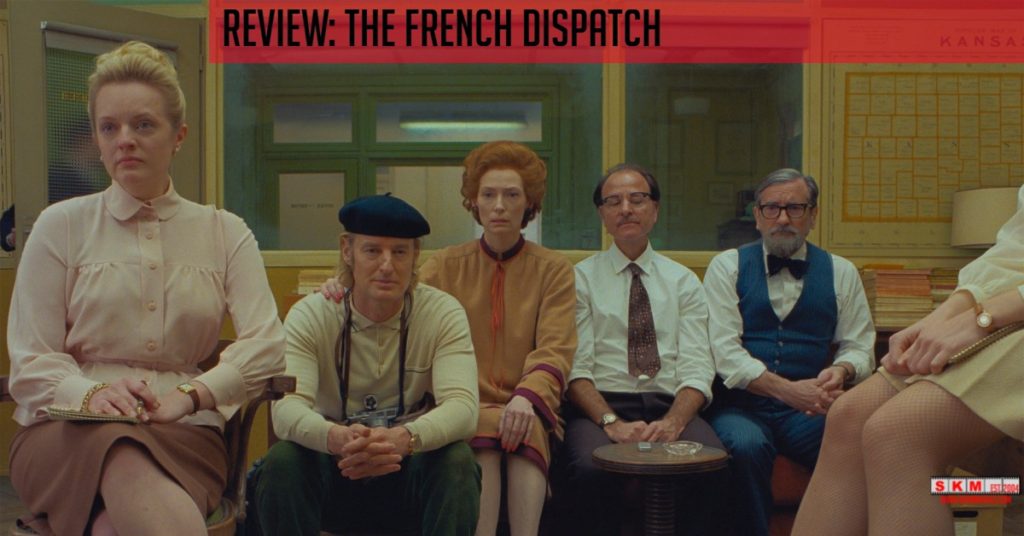Wes Anderson presents us with an obituary, travel guide, and 3 featured articles from a fiction magazine in The French Dispatch. Arthur Howitzer, Jr. (Bill Murray) was found dead of an apparent heart attack while preparing the final issue of his magazine “The French Dispatch,” a supplement of the Liberty Kansas Evening Sun, detailing life in Ennui-sur-Blasé, France. Along with Howitzer’s obituary, the issue features a travel guide from the Cycling Reporter Herbsaint Sazerac (Owen Wilson), a biography by J.K.L. Berensen (Tilda Swinton) about the convicted murderer and genius artist Moses Rosenthaler (Benicio Del Toro), a political piece by Lucinda Krementz (Frances McDormand) about teenage revolutionary Zeffirelli (Timothée Chalamet), and a food column by Roebuck Wright (Jeffrey Wright) about his private dinner with The Commissaire (Mathieu Amalric) and acclaimed prison chef Nescaffier (Stephen Park).
The French Dispatch is the latest oddity from writer/director Wes Anderson, which is framed as an anthology consisting of articles from the titular magazine, which is loosely inspired by the “New Yorker Magazine.” During the opening obituary segment (narrated by Angelica Huston), we meet the staff of “The French Dispatch,” which includes editor Arthur Howitzer, Jr., Cartoonist (Jason Schwartzman), the Story Editor (Fisher Stevens), the Legal Advisor (Griffin Dunne), and the Copy Editor (Elisabeth Moss).
The majority of the plot of The French Dispatch comes from the three featured articles from various sections of the magazine. First up is the Art and Artists piece “The Concrete Masterpiece” by J.K.L. Berensen about imprisoned artist Moses Rosenthaler, who finds a muse in the form of a prison guard Simone (Léa Seydoux) and whose work catches the attention of Julian Cadazio (Adrien Brody) and his uncles Nick (Bob Balaban) and Joe (Henry Winkler). In the Politics and Poetry article “Revisions to a Manifesto,” Lucinda Krementz follows student protestor Zeffirelli and his efforts to prepare a manifesto, much to the annoyance of his girlfriend Juliette (Lyna Khoudri). Finally, the Tastes and Smell article “The Private Dining Room” begins with Roebuck Wright recounting his private dinner with The Commissaire, though it turns into an effort to save The Commissaire’s son Gigi (Winsen Ait Hellal) from a group lead by “The Chauffeur” (Edward Norton), who wants criminal accountant Albert the Abacus (Willem Dafoe) freed from the “chicken coop.”
It has been 25 years since Wes Anderson made his feature film debut with 1996’s Bottle Rocket and in that time he both perfected his almost theatrical visual style and has amassed a large team of recurring actors, the longest-tenured of which being Bill Murray and Owen Wilson, with the latter being a collaborator since the very beginning. The French Dispatch is stacked with a cast both old and new, some much more prominent than others. For instance, Elizabeth Moss is only featured in the office scenes that act as a framing device for the larger stories and you have actors like Willem Dafoe and Saoirse Ronan make what can only be described as cameos.
In a similar fashion to Wes Anderson’s last live-action effort The Grand Budapest Hotel, The French Dispatch is presented in a square 4:3 aspect ratio, with the main stories being presented primarily in black and white, with the occasional flash of colour. Part of the reason for this is the mimic of the look of French New Wave films, particularly The 400 Blows by François Truffaut and the films of Jean-Luc Goddard.
While I would overall say that I somewhat enjoyed The French Dispatch, I would also have to argue that it is more of the same from Wes Anderson. There is nothing inherently bad with that, but I do have to say that his style does start to feel old after a while and I almost want him to try something new with his next film.
The French Dispatch opens on Friday, October 22, 2021
Related Links
- Isle of Dogs
- The Grand Budapest Hotel
- Moonrise Kingdom
- The Darjeeling Limited and Hotel Chevalier
- Blindspot: Bottle Rocket




